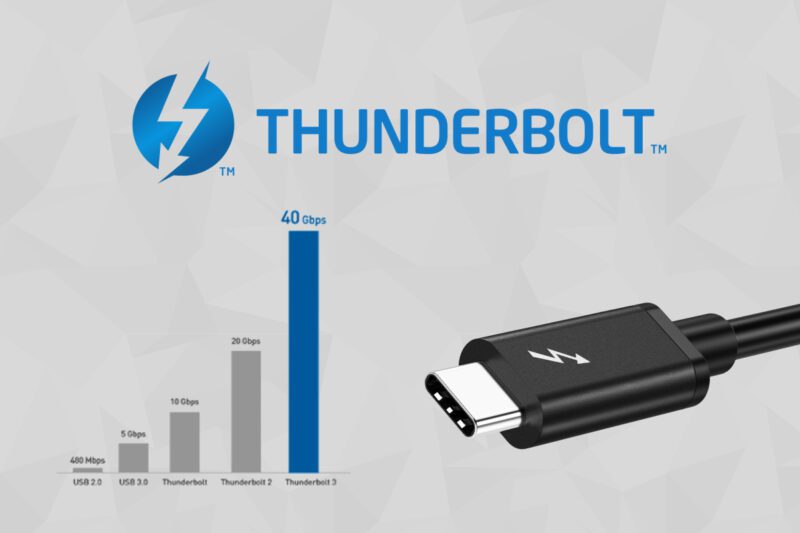Thunderbolt technology is revolutionizing the way we connect and transfer data. It’s a high-speed, versatile connection technology that provides faster performance and more bandwidth than any other connection type. With Thunderbolt, you can connect multiple high-performance devices to a single port, allowing you to consolidate your peripherals and reduce the number of cables in your workspace.
Thunderbolt technology also supports the latest 4K displays, high-resolution cameras, and other devices that require large amounts of data throughput. Whether you’re a creative professional, a gamer, or someone who just needs to move large files quickly, Thunderbolt technology can help you get the job done faster and more efficiently.
Read on to learn more about this amazing technology and how it can benefit you.
What is Thunderbolt technology?
The Thunderbolt technology brand is used to describe two different connection technologies: Thunderbolt and Thunderbolt 2.
Thunderbolt, the first version of the technology, was released in 2011 as a joint effort between Apple and Intel. It was designed to provide a high-speed, high-bandwidth connection for connecting computers and peripherals.
Thunderbolt 2 was released in 2013 as an update to the original Thunderbolt standard. It added a few new features, including support for more types of devices and cabling, but it’s essentially the same technology.
Thunderbolt 3 was released in 2016 and updated the technology again. Thunderbolt 3 is the same as Thunderbolt 2, but it uses a USB-C connector rather than a Mini DisplayPort connector.
The name “Thunderbolt” was created to describe the technology’s speed, but also to give it an edgy, aggressive tone that would appeal to creative professionals.
Thunderbolt technology initially provided transfer speeds of 10Gbps and a maximum bandwidth of 20Gbps.
The latest version, Thunderbolt 3, provides transfer speeds of up to 40Gbps and a maximum bandwidth of 82Gbps.
How does Thunderbolt technology work?
Much like an Ethernet cable transfers data over an Internet connection, Thunderbolt technology uses a digital data connection to transfer data between devices.
Thunderbolt cables are wired for bi-directional communication and provide a full-duplex connection; this means that both ends of the connection can be in use simultaneously. Because Thunderbolt data is digital, it doesn’t suffer from the transmission issues that affect analog data, like signal noise or interference.
Thunderbolt technology provides an end-to-end connection between devices, ensuring the highest data transfer speeds, no matter what types of devices you’re connecting.
Thunderbolt devices and cables establish their connection through an authentication process that ensures you’re connecting to the correct device or cable. Once the connection is established, the devices are capable of communicating with one another and transferring data at rates as high as 10Gbps.
This technology also allows you to daisy chain multiple devices to a single port, allowing you to connect many devices to your computer. This can reduce the number of ports you have to plug into your computer and minimize the number of cords you have to use while working.
It has many in common with The Pros and Cons of Investing in a Docking Station.
Benefits of Thunderbolt
There are many benefits to using Thunderbolt to connect your devices.
One of the most obvious benefits is the high transfer speeds that Thunderbolt technology provides. Thunderbolt 3 can transfer data up to 40 times faster than a standard USB connection and delivers consistent transfer rates, even when multiple devices are connected. This means you can move large files at lightning speed, without worrying about your connection slowing down.
Thunderbolt cable also provides more bandwidth than other connection types, so you can connect more devices to your computer and transfer larger files at one time. This is particularly helpful for creative professionals who need to move large files between devices quickly, such as photographers who transfer large image files between their computer and camera, or designers who need to transfer large design files between computers.
Another benefit of using Thunderbolt is that it supports a wide range of devices, including computers, docking stations, usb-c hubs, monitors, cameras, and printers.
Thunderbolt technology for 4K displays
If you regularly view high-resolution images or videos, such as 4K video, using a 4K display with Thunderbolt is a great option.
A single Thunderbolt port can support two 4K displays, so you can connect two high-resolution monitors to your computer and easily switch between them.
This is helpful for any creative professionals who need to view large amounts of high-resolution images or video while working on projects, or for gamers who like to play games in full HD on two monitors at the same time.
A single Thunderbolt port can also support two 5K displays, which are beneficial for photographers and designers who need to view high-resolution images at their full resolution -> single Thunderbolt port can support up to six 4K displays.
Using a high-bandwidth storage device, like an external hard drive, you can store large amounts of high-resolution images and video and transfer large video files quickly between computers.





